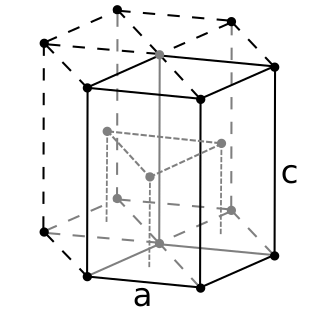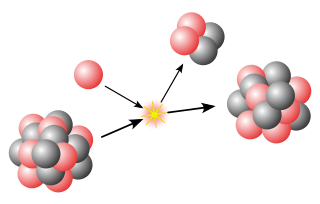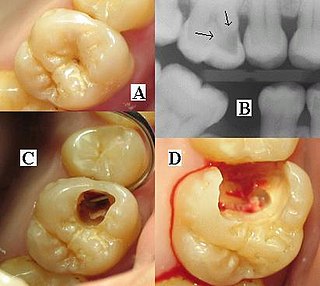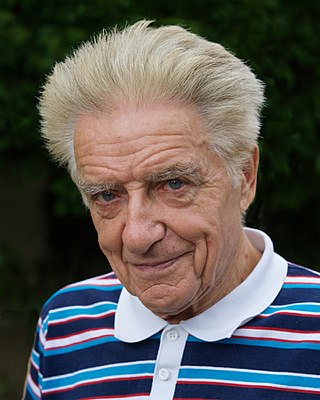Related Research Articles

Californium is a radioactive chemical element with the symbol Cf and atomic number 98. The element was first synthesized in 1950 at Lawrence Berkeley National Laboratory, by bombarding curium with alpha particles. It is an actinide element, the sixth transuranium element to be synthesized, and has the second-highest atomic mass of all elements that have been produced in amounts large enough to see with the naked eye. The element was named after the university and the U.S. state of California.

Hassium is a chemical element with the symbol Hs and the atomic number 108. Hassium is highly radioactive; its most stable known isotopes have half-lives of approximately ten seconds. One of its isotopes, 270Hs, has magic numbers of both protons and neutrons for deformed nuclei, which gives it greater stability against spontaneous fission. Hassium is a superheavy element; it has been produced in a laboratory only in very small quantities by fusing heavy nuclei with lighter ones. Natural occurrences of the element have been hypothesised but never found.

Meitnerium is a synthetic chemical element with the symbol Mt and atomic number 109. It is an extremely radioactive synthetic element. The most stable known isotope, meitnerium-278, has a half-life of 4.5 seconds, although the unconfirmed meitnerium-282 may have a longer half-life of 67 seconds. The GSI Helmholtz Centre for Heavy Ion Research near Darmstadt, Germany, first created this element in 1982. It is named after Lise Meitner.
A dirty bomb or radiological dispersal device is a radiological weapon that combines radioactive material with conventional explosives. The purpose of the weapon is to contaminate the area around the dispersal agent/conventional explosion with radioactive material, serving primarily as an area denial device against civilians. It is not to be confused with a nuclear explosion, such as a fission bomb, which produces blast effects far in excess of what is achievable by the use of conventional explosives. Unlike the cloud of radiation from a typical fission bomb, a dirty bomb’s radiation can be dispersed only within a few hundred meters or a few miles of the explosion.

In nuclear physics, the island of stability is a predicted set of isotopes of superheavy elements that may have considerably longer half-lives than known isotopes of these elements. It is predicted to appear as an "island" in the chart of nuclides, separated from known stable and long-lived primordial radionuclides. Its theoretical existence is attributed to stabilizing effects of predicted "magic numbers" of protons and neutrons in the superheavy mass region.
Tennessine is a synthetic chemical element with the symbol Ts and atomic number 117. It is the second-heaviest known element and the penultimate element of the 7th period of the periodic table.

Kaarlo Jaakko Juhani Hintikka was a Finnish philosopher and logician.

Industrial radiography is a modality of non-destructive testing that uses ionizing radiation to inspect materials and components with the objective of locating and quantifying defects and degradation in material properties that would lead to the failure of engineering structures. It plays an important role in the science and technology needed to ensure product quality and reliability. In Australia, industrial radiographic non-destructive testing is colloquially referred to as "bombing" a component with a "bomb".

Dental radiographs, commonly known as X-rays, are radiographs used to diagnose hidden dental structures, malignant or benign masses, bone loss, and cavities.

Fast neutron therapy utilizes high energy neutrons typically between 50 and 70 MeV to treat cancer. Most fast neutron therapy beams are produced by reactors, cyclotrons (d+Be) and linear accelerators. Neutron therapy is currently available in Germany, Russia, South Africa and the United States. In the United States, one treatment center is operational, in Seattle, Washington. The Seattle center uses a cyclotron which produces a proton beam impinging upon a beryllium target.

Ancient Greek technology developed during the 5th century BC, continuing up to and including the Roman period, and beyond. Inventions that are credited to the ancient Greeks include the gear, screw, rotary mills, bronze casting techniques, water clock, water organ, the torsion catapult, the use of steam to operate some experimental machines and toys, and a chart to find prime numbers. Many of these inventions occurred late in the Greek period, often inspired by the need to improve weapons and tactics in war. However, peaceful uses are shown by their early development of the watermill, a device which pointed to further exploitation on a large scale under the Romans. They developed surveying and mathematics to an advanced state, and many of their technical advances were published by philosophers, like Archimedes and Heron.
In radiobiology, the relative biological effectiveness is the ratio of biological effectiveness of one type of ionizing radiation relative to another, given the same amount of absorbed energy. The RBE is an empirical value that varies depending on the type of ionizing radiation, the energies involved, the biological effects being considered such as cell death, and the oxygen tension of the tissues or so-called oxygen effect.

The roentgen or röntgen is a legacy unit of measurement for the exposure of X-rays and gamma rays, and is defined as the electric charge freed by such radiation in a specified volume of air divided by the mass of that air . In 1928, it was adopted as the first international measurement quantity for ionizing radiation to be defined for radiation protection, as it was then the most easily replicated method of measuring air ionization by using ion chambers. It is named after the German physicist Wilhelm Röntgen, who discovered X-rays and was awarded the first Nobel Prize in Physics for the discovery.

The Los Alamos Neutron Science Center (LANSCE), formerly known as the Los Alamos Meson Physics Facility (LAMPF), is one of the world's most powerful linear accelerators. It is located in Los Alamos National Laboratory in New Mexico in Technical Area 53. It was the most powerful linear accelerator in the world when it was opened in June 1972. The technology used in the accelerator was developed under the direction of nuclear physicist Louis Rosen. The facility is capable of accelerating protons up to 800 MeV. Multiple beamlines allow for a variety of experiments to be run at once, and the facility is used for many types of research in materials testing and neutron science. It is also used for medical radioisotope production.
The shear strength of a discontinuity in a soil or rock mass may have a strong impact on the mechanical behavior of a soil or rock mass. The shear strength of a discontinuity is often considerably lower than the shear strength of the blocks of intact material in between the discontinuities, and therefore influences, for example, tunnel, foundation, or slope engineering, but also the stability of natural slopes. Many slopes, natural and man-made, fail due to a low shear strength of discontinuities in the soil or rock mass in the slope. The deformation characteristics of a soil or rock mass are also influenced by the shear strength of the discontinuities. For example, the modulus of deformation is reduced, and the deformation becomes plastic rather than elastic. This may cause, for example, larger settlement of foundations, which is also permanent even if the load is only temporary. Furthermore, the shear strength of discontinuities influences the stress distribution in a soil or rock mass.

Heavy metals are generally defined as metals with relatively high densities, atomic weights, or atomic numbers. The criteria used, and whether metalloids are included, vary depending on the author and context. In metallurgy, for example, a heavy metal may be defined on the basis of density, whereas in physics the distinguishing criterion might be atomic number, while a chemist would likely be more concerned with chemical behaviour. More specific definitions have been published, but none of these have been widely accepted. The definitions surveyed in this article encompass up to 96 out of the 118 known chemical elements; only mercury, lead and bismuth meet all of them. Despite this lack of agreement, the term is widely used in science. A density of more than 5 g/cm3 is sometimes quoted as a commonly used criterion and is used in the body of this article.
Spinal cord injury without radiographic abnormality (SCIWORA) is symptoms of a spinal cord injury (SCI) with no evidence of injury to the spinal column on X-rays or CT scan. Symptoms may include numbness, weakness, abnormal reflexes, or loss of bladder or bowel control. Neck or back pain is also common. Symptoms may be brief or persistent. Some do not develop symptoms until a few days after the injury.

Wolfgang Kundt is a German astrophysicist. He studied Theoretical Physics in Hamburg, centered on general relativity, and got his diploma in 1956 and his PhD in 1959, advised by Pascual Jordan.
Stanton H. Cohn was an expert in osteoporosis and the head of the Medical Physics Division at Brookhaven National Lab.
Christian Alfred Elie Janot was a French physicist and materials scientist known for his work on materials characterization using Mössbauer spectroscopy and his physical metallurgy studies of quasicrystals and noncrystalline materials using neutron scattering techniques.
References
- Berger, Harold (1976). Neutron Radiography and Gaging. American Society for Testing and Materials. LCCN 75-13061.
- Von Der Hardt, 1P; Rottger, H (1981). Neutron Radiography Handbook. D. Reidel Publishing Company. ISBN 90-277-1378-2.
- Markgraf, J.F.W. (1987). Collimators for Thermal Neutron Radiography. Springer Media. ISBN 90-277-2568-3.
- Domanus, J.C. (1992). Practical Neutron Radiography. Springer Media. ISBN 0-7923-1860-9.
- Brenizer, JS (2013). "A review of significant advances in neutron imaging from conception to the present". Physics Procedia. 43 (43): 10–20. Bibcode:2013PhPro..43...10B. doi: 10.1016/j.phpro.2013.03.002 .
- De Beer, FC; Franklyn, CB (October 3–8, 2010). "Proceedings of the 9th World Conference". 651 (1).
{{cite journal}}: Cite journal requires|journal=(help)